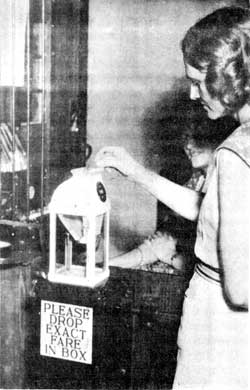
 | ||||||||||
| Intro | Author | Subject | Volume | Volume/Title | NPS | |||||
|
Volume I - No. 4 |
October, 1938 |
|
HOW ADMISSION FEES WORK AT FORT MARION By Herbert E. Kahler, The collection of fees at Fort Marion dates back to 1914. In that year, a devastating fire destroyed the building of the St. Augustine Historical Association and a part of its collection. Chauncey Depew, President of the St. Augustine Historical Society, requested the Secretary of War for permission to display what was left of the collection at Fort Marion, and asked for the privilege of accepting contributions for the payment of guide service. 
At first, voluntary contributions were requested from the visitors, but as time went on, it was decided to collect a flat fee of 25 cents per person. There was considerable objection on the part of visitors to the charge of 25 cents, and since the income was decreasing with this system, the Historical Society reverted to its former policy of asking for voluntary contributions. The system of collecting voluntary contributions (which some claim were involuntarily given) appears to have been a lucrative one, for when Fort Marion was transferred from the War Department to the National Park Service, under the Department of Interior, the Historical Society was paying a yearly franchise fee of $1,400, and made a vigorous effort to renew its contract in 1935. There were, however, other organizations in the community, who opposed the operation of government property for the profit of a semi-public organization. Moreover, they believed that the government would operate the area without charge to the visitor. In July, 1935, the National Park Service took over the operation of Fort Marion, and in August, 1938, a fee of 10 cents was levied on all except children under 12 years of age. After six weeks of operation, we are convinced that, at least for Fort Marion, the collection of fees is a good thing. Even though the visitor pays but a dime, we find by observation that he follows through the education program more closely and asks more questions than heretofore. He has paid for something and wants to get his money' s worth. On the other hand, we find the guides more alert in presenting the program and answering questions. The collection of a fee has helped maintain order. In the past, Fort Marion on Sundays served as a fashion show for the colored folk, and young people from neighboring communities made Fort Marion their objective in the weekly trek from the home town. In general, these groups were not interested in the educational program and were an annoyance to those who were. Very few complaints have come to our attention concerning the levying of a fee. On the contrary, there have been many words of praise. Many a visitor has said "This is the biggest dime's worth I have ever received!" What does the visitor get for a dime? He gets a 45-minute tour consisting of: 1. A trip around the terreplein, with an explanation of the strategic location of the fort, the nature of its construction, and the role the fort played in colonial history; 2. An examination of the case-mates -- living quarters, storerooms, powder magazine, chapel, kitchens and dungeons, with a description of their actual use, and, 3. A presentation of 30 slides, showing important persons, pictorial maps of sieges, construction plans of the fort, and outstanding architectural features. There has been some objection on the part of local people; not to the policy of collecting fees, but rather to the collection of fees from them. Other points of interest in St. Augustine, such as the Alligator Farm, the Oldest House and the Fountain of Youth, admit local residents without charge. This problem is not considered a serious one, however, because the number of local visitors is small. The income from fees for the month of August was $1,986. The visitation to the area was 2l,898, which shows approximately 8,000 less than for the same month last year. The most noticeable decreases were on Sundays. Equipment for handling the collection of fees consists of a safe, an Ohmer registering fee box and a Brandt changer. The turnstile was made at Fort Marion. Both the turnstile and railing, situated in the sally port, can be removed readily. Fees are collected by two bonded ERA employees. Deposits are made daily by money order. On the basis of so limited a trial, we can make only tentative conclusions, yet from the number of persons who have passed through Fort Marion National Monument, we incline to believe the traveling public does not object to the charge of a nominal fee for personal services. Parking area observation shows few visitors have turned away after reading the announcement of a charge for guide service. | |
| <<< Previous | > Contents < | Next >>> | ||
|
http://www.cr.nps.gov/history/online_books/regional_review/vol1-4g.htm Date: 04-Jul-2002 | ||||